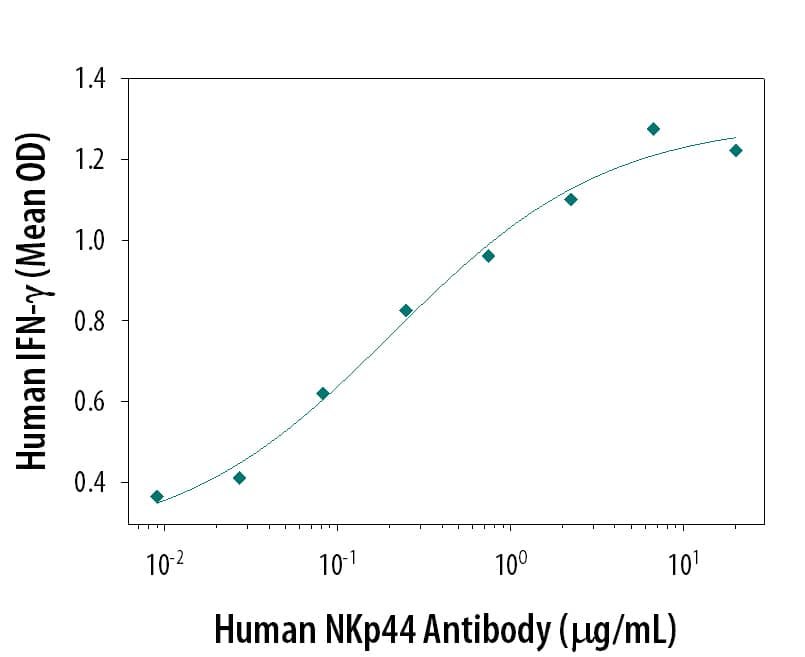Human NKp44/NCR2 Antibody
R&D Systems, part of Bio-Techne | Catalog # AF2249


Key Product Details
Species Reactivity
Applications
Label
Antibody Source
Product Specifications
Immunogen
Gln22-Pro190, predicted
Accession # O95944
Specificity
Clonality
Host
Isotype
Endotoxin Level
Scientific Data Images for Human NKp44/NCR2 Antibody
Human NKp44 Antibody Induces IFN-gamma Secretion in Human NK Cells.
Human NKp44 Antigen Affinity-purified Polyclonal Antibody induces IFN-gamma secretion in human natural killer (NK) cells activated with 1,000 U/mL Recombinant Human IL-2 (Catalog # 202-IL), in a dose-dependent manner, as measured using the Quantikine Human IFN-gamma ELISA Kit (Catalog # DIF50C). The ED50 for this effect is typically 0.2-0.6 µg/mL.Applications for Human NKp44/NCR2 Antibody
Agonist Activity
Sample: Human natural killer (NK) cells activated with Recombinant Human IL-2 (Catalog # 202-IL)
Western Blot
Sample: Recombinant Human NKp44/NCR2 Fc Chimera (Catalog # 2249-NK)
Formulation, Preparation, and Storage
Purification
Reconstitution
Formulation
Shipping
Stability & Storage
- 12 months from date of receipt, -20 to -70 °C as supplied.
- 1 month, 2 to 8 °C under sterile conditions after reconstitution.
- 6 months, -20 to -70 °C under sterile conditions after reconstitution.
Background: NKp44/NCR2
NKp44, along with NKp30 and NKp46, constitute a group of receptors termed "Natural Cytotoxicity Receptors" (NCR) (1). These receptors are expressed almost exclusively by NK cells and play a major role in triggering NK-mediated killing of most tumor cell lines. No rodent ortholog to NKp44 has been identified. Human NKp44, also known as NCR2, is a 44 kDa type I transmembrane glycoprotein that is characterized by the presence of one extracellular V-like immunoglobulin domain (2). It is synthesized as a 276 amino acid (aa) precursor that contains a 21 aa signal sequence, a 171 aa extracellular region, a 21 aa transmembrane segment and a 63 aa cytoplasmic tail. Alternate splicing in both the cytoplasmic tail and extracellular region generates multiple isoforms of unknown significance. The Ig-like region is unaffected. A physical association with the ITAM-bearing accessory protein, DAP12, occurs via a charged residue in the NKp44 transmembrane domain. Ligation of NKp44 with a specific antibody results in phosphorylation of DAP12 (3) and activation of target cell lysis in a redirected killing assay (4). NKp44 is absent from resting NK cells but is up‑regulated upon activation with IL-2. Activation-induced expression occurs in the CD56dim CD16+ NK subset that accounts for more than 85% of NK cells found in peripheral blood and spleen, as well as the CD56bright CD16- NK subset that constitutes the majority of NK cells in lymph node and tonsil (5). Studies with neutralizing antibodies reveal that NKp44 is partially responsible for triggering lytic activity against several tumor cell types (2, 6). Blocking any of the individual NCRs results in partial inhibition of tumor cell lysis, but nearly complete inhibition of lysis is observed if all three receptors are blocked simultaneously (6). NKp44 has also been implicated in recognition of virus-infected cells through its capacity to bind to viral hemagglutinins (7).
References
- Moretta, L. and A. Moretta (2004) EMBO J. 23:255.
- Cantoni, C. et al. (1999) J. Exp. Med. 189:787.
- Augugliaro, R. et al. (2003) Eur. J. Immunol. 33:1235.
- Vitale, M. et al. (1998) J. Exp. Med. 187:2065.
- Ferlazzo, G. et al. (2004) J. Immunol. 172:1455.
- Pende, D. et al. (1999) J. Exp. Med. 190:1505.
- Arnon, T. et al. (2001) Eur. J. Immunol. 31:2680.
Long Name
Alternate Names
Gene Symbol
UniProt
Additional NKp44/NCR2 Products
Product Documents for Human NKp44/NCR2 Antibody
Product Specific Notices for Human NKp44/NCR2 Antibody
For research use only